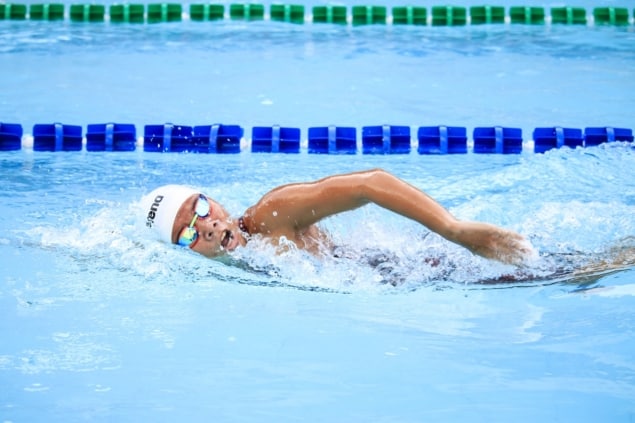Wearable patch measures sweat in extreme environments
26 Jan 2019
A research team led by John Rogers at Northwestern University in the US has unveiled a thin and robust sweat sensor that is capable of monitoring hydration during exercise. The circular patch, with a width of just 30 mm, works underwater and in dry, arid environments – which makes it ideal for monitoring fluid loss during swimming, triathlons, ultramarathons and many other endurance sports.
Since people sweat at different rates, it is very difficult to know how much fluid athletes lose through perspiration. This can be a major problem, as drinking too much water can lead to hyponatremia, which in acute cases can cause headaches, seizures or even coma. Meanwhile, drinking too little risks hypohydration, which can produce extreme symptoms that include delirium as well as increased risk of heat stroke and death.
The current gold standards for monitoring sweat are either absorbent foam stickers or the so-called body washdown method – which essentially involves collecting shower run-off. Neither of these methods lend themselves to real-time monitoring during endurance sports.
Endurance challenge
Members of the study team had developed wearable sensors before, such as temporary tattoos to monitor trace metal in sweat or heart beats, brain waves and muscle contractions. But none of these devices were built to cope with the difficulties inherent to collecting sweat in aquatic or arid environments. When swimming, it can be difficult not to let water from the pool or the sea mix with sweat in a sensor. On land, meanwhile, sweat can rapidly evaporate when the weather is hot and dry.
To overcome these challenges, Rogers and colleagues built a thin, stretchable device to monitor sweat. It consists of a microfluidic channel laid out in a circular serpentine pattern, together with electronic modules that include a flexible magnetic-loop antenna, a small wireless temperature sensor, near-field communication components and a light-emitting diode for user notification.
“The sweat glands under the device act as a pump that push sweat into a microchannel,” explains team member Jonathan Reeder. “A small amount of colour agent is placed at the beginning of the microchannel, which dyes the sweat a shade of purple that corresponds to chloride concentration. Sweat rate and sweat loss can be determined by visually observing the number of serpentines that are filled.”The wearable device, which does not need a battery or wireless technology, can collect real-time data on sweat loss, sweat rate, chloride concentration and skin temperature. This data can then be read by tapping it with a smartphone equipped with near-field communications technology – which enables data transfer without an Internet connection.
The innovation, however, lies in how these components are put together. The design combines a strong, skin-safe adhesive with a very thin, flexible device structure. A watertight bond is formed to the skin at the inlet of the microchannel, and there is a very small outlet for air to escape as sweat fills the channel – transforming the patch into a robust watertight one-way valve.
Extreme field tests
To test the device, the team attached the hi-tech patch to dozens of cyclists, swimmers and triathletes, the latter practicing for the IRONMAN Triathlon World Championship. Results were encouraging, with the patch performing well – even after two hours of vigorous swimming.
Given its proven utility, the researchers are already thinking about bringing their innovation to market. “One of the unique features of these devices is the simplicity and low material cost,” says Reeder. “A startup from the lab, Epicore Biosystems, is working in this area to commercialize similar devices.”
The research is described in Science Advances.And it could prove useful in other areas too. “We can store collected sweat for hours after sweating,” Reeder says. “We could collect sweat at very low rates during normal everyday activities, which could be useful for vulnerable populations.” This could mean less awkward tests to screen for cystic fibrosis in babies, which is detected by measuring sweat chloride concentration, and better recovery monitoring for stroke patients.
28/01/2019 FROM PHYSICSWORLD.COM

Δεν υπάρχουν σχόλια:
Δημοσίευση σχολίου